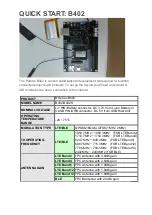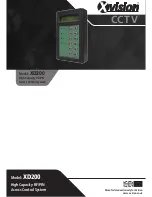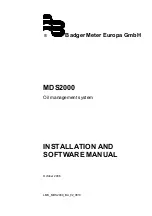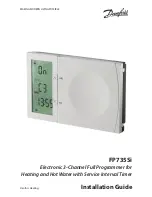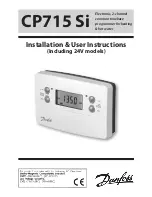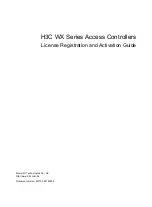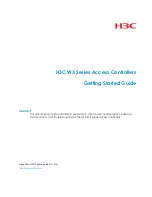
NOTICE
All instructions, warranties and other collateral documents are subject to change at the sole discretion of Horizon Hobby, Inc.
For up-to-date product literature, visit horizonhobby. com and click on the support tab for this product.
Meaning of Special Language
The following terms are used throughout the product literature to indicate various levels of potential harm when operating
this product:
NOTICE:
Procedures, which if not properly followed, create a possibility of physical property damage AND a little or no
possibility of injury.
CAUTION:
Procedures, which if not properly followed, create the probability of physical property damage AND a possibility
of serious injury.
WARNING:
Procedures, which if not properly followed, create the probability of property damage, collateral damage, and
serious injury OR create a high probability of superficial injury.
WARNING:
Read the ENTIRE instruction manual to become familiar with the features of the product before operating.
Failure to operate the product correctly can result in damage to the product, personal property and cause serious
injury.
This is a sophisticated hobby product. It must be operated with caution and common sense and requires some basic mechani-
cal ability. Failure to operate this Product in a safe and responsible manner could result in injury or damage to the product or
other property. This product is not intended for use by children without direct adult supervision. Do not attempt disassembly,
use with incompatible components or augment product in any way without the approval of Horizon Hobby, Inc. This manual
contains instructions for safety, operation and maintenance. It is essential to read and follow all the instructions and warnings
in the manual, prior to assembly, setup or use, in order to operate correctly and avoid damage or serious injury.
Age Recommendation: Not for children under 14 years. This is not a toy.
Features
• Rev limiter to protect the motor and drive train components, allowing brief operation of the motor out of water
• Water-cooled motor for optimum performance without the need for large heat sinks
• Soft start to limit the initial throttle current to increase the life of electronic components
• Cutoff voltage indicator to stop the motor from operating if the battery pack is reaching full discharge
• High-power FET control with proportional forward and reverse
• High-frequency design to deliver smooth speed transition
• Pre-wired EC3
™
battery connector, 4.0mm bullet-style motor connectors and universal receiver plug
Specifications
Operation Proportional forward and reverse
BEC voltage 5.8V
BEC current limit 5A
Minimum input voltage 7.2V
DYN3810
DYN3815
DYN3820
Maximum input voltage 11.1V
14.8V
22.2V
Continuous current 45A
60A
80A
Maximum peak current 60A
80A
100A
Mounting the ESC
IMPORTANT:
Make sure the ESC connection leads reach the battery pack, motor and receiver before you install the ESC in the
hull.
Use double-sided foam tape or hook and loop fastener (not included) to secure the ESC inside the hull. Refer to the instruction
manual included with your boat for suggested ESC mounting locations.
Motor power
leads
Water cooling connections Battery leads
Connecting the ESC to the Receiver
The ESC uses the boat battery to supply power to the receiver. A separate receiver battery is not necessary. Connect the
receiver lead on the ESC to the throttle channel on the receiver, noting proper polarity.
Orange Wire—Signal
Red Wire—Positive
Brown Wire—Negative
Connecting the ESC to the Motor
Connect the three bullet connectors to the motor in any order. If the motor spins in the wrong direction, simply switch any two
bullet connectors.
Water Cooling Connections
1. Connect the rudder pickup to the ESC IN
2. Connect the ESC OUT to the MOTOR IN
3. Connect the MOTOR OUT to the water outlet on the hull
Battery Chemistry Switch
ON = Li-Po
OFF = Ni-MH
Connecting the Battery to the ESC
1. Make sure the ESC switch is in the OFF position.
2. Connect a fully charged battery pack(s) to the EC3
connector(s).
3. Power on the transmitter.
4. Move the ESC switch to the ON position.
Adjusting the Transmitter
1. Select NORMAL for the throttle channel direction on the
transmitter.
2. Move the throttle trim to the CENTER position.
3. Make sure the throttle channel expo is off or set to 0
(if available).
4. Set the throttle channel TRAVEL to 100% in both forward
and reverse directions.
5. If the transmitter has an adjustable trigger or throttle
stick, move it to the 70/30 position. Refer to your trans-
mitter’s instructions for specific transmitter programming.
Detecting Full Throttle Position
1. Power on the transmitter.
2. Move the throttle trim to the CENTER position.
3. Power on the ESC.
If you do not hear a tone:
a. Power off the ESC.
b. Disconnect the battery pack(s) from the ESC.
c. Wait 5 seconds.
d. Connect the battery pack(s) to the ESC.
e. Power on the ESC.
4. The ESC automatically detects the full throttle position.
5. Power off the ESC.
6. Disconnect the battery pack(s) from the ESC.
7. Power off the transmitter.
ESC Programming
Basic ESC programming can be accomplished through the transmitter. A Dynamite® Marine ESC Programming Card
(DYNM3821) makes programming much easier and is required in order to re-program some functions. Following are the func-
tions that have the ability to be re-programmed to suit your individual needs:
• Brake On/Off
• Motor timing
• Throttle Curve (requires DYNM3821)
• Cutoff Voltage (requires DYNM3821)
• Cutoff Type (requires DYNM3821)
• Throttle Reverse
(requires DYNM3821)
Changing Brake On/Off
1. Power on the transmitter.
2. Connect a fully charged battery pack(s) to the ESC.
3. Move the throttle trigger or stick to the full throttle posi-
tion.
4. Hold full throttle and power on the ESC.
5. Continue holding full throttle. Wait 5 seconds.
6. After 5 seconds, you will hear four tones.
7. Quickly move the throttle to the full brake position. You
will hear two tones.
8. The brake is now turned OFF.
The brake setting will not change after disconnecting the
battery pack. You will hear one tone when the ESC is pow-
ered ON and the brake is ON. You will hear two tones when
the ESC is powered ON and the brake is OFF.
Repeat steps 1–8 to turn the brake ON.
Changing Motor Timing
Two timing modes available:
Low timing:
Use with 2-, 4- or 6-pole inrunner motors. Low timing provides maximum efficiency. Always use low timing for
initial
operation.
High timing:
Use with 6+ pole inrunner or outrunner motors. High timing increases both motor RPM and current draw (up
to 20% increase compared to low timing) using the same battery pack and prop. You will notice a substantial decrease in run
time using the high timing mode.
Timing testing
If the temperature of the batteries, ESC and motor are cool to the touch after operation using low timing, it is possible to test
using the high timing mode. Never use high timing with 2-pole motors, regardless of temperature.
To change motor timing modes:
1. Power on the transmitter.
2. Connect a fully charged battery pack(s) to the ESC.
3. Move the throttle trigger or throttle stick to the full throttle position.
4. Hold full throttle and power on the ESC.
5. Continue to hold full throttle. After 10 seconds, you will hear 5 tones.
5 single tone sequence = low timing
5 double tone sequence = high timing
6. Move the throttle to full brake during the desired sequence to select the timing option.
7. The ESC confirms the timing option with a single tone (low timing) or a double tone (high timing). The timing setting does not
change after disconnecting the battery pack.
Default Settings
Reverse On
Cutoff voltage High
Cutoff type Hard
Brake On
Timing Low
Throttle curve Logarithmic
HINWEIS
Alle Anweisungen, Garantien und anderen zugehörigen Dokumente können im eigenen Ermessen von Horizon Hobby, Inc.
jederzeit geändert werden. Die aktuelle Produktliteratur finden Sie auf horizonhobby.com unter der Registerkarte „Support“
für das betreffende Produkt.
Spezielle Bedeutungen
Die folgenden Begriffe werden in der gesamten Produktliteratur verwendet, um auf unterschiedlich hohe Gefahrenrisiken
beim Betrieb dieses Produkts hinzuweisen:
HINWEIS:
Wenn diese Verfahren nicht korrekt befolgt werden, können sich möglicherweise Sachschäden UND geringe oder
keine Gefahr von Verletzungen ergeben.
ACHTUNG:
Wenn diese Verfahren nicht korrekt befolgt werden, ergeben sich wahrscheinlich Sachschäden UND die Gefahr
von schweren Verletzungen.
WARNUNG:
Wenn diese Verfahren nicht korrekt befolgt werden, ergeben sich wahrscheinlich Sachschäden,
Kollateralschäden und schwere Verletzungen ODER mit hoher Wahrscheinlichkeit oberflächliche Verletzungen.
WARNUNG:
Lesen Sie die GESAMTE Bedienungsanleitung, um sich vor dem Betrieb mit den Produktfunktionen
vertraut zu machen. Wird das Produkt nicht korrekt betrieben, kann dies zu Schäden am Produkt oder persönlichem
Eigentum führen oder schwere Verletzungen verursachen.
Dies ist ein hochentwickeltes Hobby-Produkt. Es muss mit Vorsicht und gesundem Menschenverstand betrieben werden und
benötigt gewisse mechanische Grundfähigkeiten. Wird dieses Produkt nicht auf eine sichere und verantwortungsvolle Weise
betrieben, kann dies zu Verletzungen oder Schäden am Produkt oder anderen Sachwerten führen. Dieses Produkt eignet sich
nicht für die Verwendung durch Kinder ohne direkte Überwachung eines Erwachsenen. Versuchen Sie nicht ohne Genehmi-
gung durch Horizon Hobby, Inc., das Produkt zu zerlegen, es mit inkompatiblen Komponenten zu verwenden oder auf jegliche
Weise zu erweitern. Diese Bedienungsanleitung enthält Anweisungen für Sicherheit, Betrieb und Wartung. Es ist unbedingt not-
wendig, vor Zusammenbau, Einrichtung oder Verwendung alle Anweisungen und Warnhinweise im Handbuch zu lesen und zu
befolgen, damit es bestimmungsgemäß betrieben werden kann und Schäden oder schwere Verletzungen vermieden werden.
Nicht geeignet für Kinder unter 14 Jahren. Dies ist kein Spielzeug.
Eigenschaften
• Drehzahlbegrenzer schützt den Motor und Antrieb und ermöglicht kurze Überprüfung des Antriebs ausserhalb des Wassers.
• Wassergekühlt für optimale Leistung, ohne die Notwendigkeit großer Kühlflächen.
• Sanftanlauf schützt und verlängert die Lebenszeit der Elektronikkomponenten.
• Niederspannungsabschaltungsindikator zum stoppen des Motors wenn der Akku die Entlade grenze erreicht hat.
• Hochleistungs FET mit proportionaler vorwärts und rückwärts Funktion.
• Hohe Taktfrequenz bietet exakte Ansteuerung.
• Vorverkabelt mit EC3 Akkuanschlüssen, Motorstecker und universellen Empfängeranschluß
Spezifikationen
Betrieb Proportional vorwärts und rückwärts
BEC Spannung 5.8V
BEC Stromgrenze 5A
Mindest Eingangsspannung 7.2V
DYN3810
DYN3815
DYN3820
Maximale Eingangsspannung 11.1V
14.8V
22.2V
Dauerstrom 45A
60A
80A
Spitzenstrom kurzz 60A
80A
100A
Montage des Reglers
WICHTIG:
Stellen Sie vor dem Befestigen an dem Montageort sicher, dass Sie die Reglerund Motorstecker erreichen können.
Bitte sehen Sie in der Bedienungsanleitung des Bootes nach wo der Regler eingebaut werden soll. Nutzen Sie zur Befestigung
doppelseitiges Klebeband (nicht im Lieferumfang).
Motoranschlüsse
Anschluß Wasserkühlung
Akkuanschlüsse
Anschluß des Reglers an den Empfänger
Der Empfänger wird über den ESC/Regler mit Strom versorgt, es ist kein zusätzlicher Empfängerakku notwendig. Schließen Sie
den Regler an den Gaskanal des Empfängers an und achten dabei bitte auf die richtige Polarität.
Orange Kabel—Signal
Rot Kabel—Positiv
Braun Kabel—Negativ
Anschluß des Reglers an den Motor
Verbinden Sie den Motor mit den drei Anschlußkabeln in beliebiger Reihenfolge. Sollte der Motor in falscher Richtung drehen,
tauschen Sie bitte zwei Anschlüsse.
Anschlüsse der Wasserkühlung
1. Schließen Sie die Leitung die vom Ruder kommt an den
Regler an.
2. Schließen Sie die Leitung des Reglerausganges an den
Motoreingang an.
3. Schließen Sie die Leitung des Motorausganges an den
Rumpfauslass an.
Akkuwahl Schalter
EIN = Li-Po
AUS = Ni-MH
Anschluß des Akkus an den Regler
1. Stellen Sie bitte sicher, dass der Reglerschalter auf OFF
(AUS) steht.
2. Schließen Sie ein vollständig geladenes Akku Pack an
den Deans Stecker an.
3. Schalten Sie den Sender ein.
4. Schalten Sie den Regler auf die ON (EIN) Position.
Einstellen des Senders
1. Stellen Sie bitte sicher, dass der Reverse Schalter des
Gaskanals auf Normal steht.
2. Stellen Sie die Trimmung des Gaskanals auf Mitte.
3. Stellen Sie einen Exponential Wert auf Null oder verfüg-
bares Minimum.
4. Stellen Sie den Servoweg (Travel) des Gaskanal zu beiden
Seiten (vorwärts u. rückwärts) auf 100% ein.
5. Sollte der Sender einen einstellbaren Gashebel haben,
stellen Sie diesen in die 70/30 Position.
Sehen Sie bitte dazu in der Bedienungsanleitung ihres
Senders nach.
Ermitteln der Vollgas Position
1. Schalten Sie den Sender ein.
2. Bringen Sie die Gastrimmung in die Mitte.
3. Schalten Sie den Regler ein.
Sollten Sie keinen Ton hören:
a. Schalten Sie den Regler aus.
b. Trennen Sie den Akku vom Regler.
c. 5 Sekunden warten.
d. Schließen Sie den Akku an den Regler an.
e. Schalten Sie den Regler ein.
4. Der Regler erkennt automatisch die Vollgas Position.
5. Schalten Sie den Regler aus.
6. Trennen Sie den Akku Pack vom Regler.
7. Schalten Sie den Sender aus.
Regler Programmierung
Die Basisprogrammierung kann durch den Sender erfolgen. Dynamite Marine ESC Programming Card (DYNM3821) macht die
Programmierung viel einfacher und wird für einige Programmierungen benötigt. Nachfolgend die Programmierungen die Sie
vornehmen können:
• Bremse Ein/Aus
• Motor timing
• Gaskurve (erfordert DYNM3821)
• Abschaltspannung
(erfordert DYNM3821)
• Abschalttyp (erfordert DYNM3821)
• Gasreversierung
(erfordert DYNM3821)
Bremse Ein/Aus
1. Schalten Sie den Sender ein.
2. Schließen Sie den Akku an den Regler an.
3. Geben Sie mit dem Gashebel Vollgas.
4. Halten Sie die Vollgasposition und schalten den Regler
ein.
5. Halten Sie die Vollgasposition für 5 Sekunden.
6. Nach 5 Sekunden hören Sie vier Töne.
7. Bringen Sie den Gashebel in die Vollbremsposition. Sie
hören dann zwei Töne.
8. Die Bremse ist dann ausgeschaltet.
Die Einstellung der Bremse wird sich nach dem Trennen
des Akkupacks nicht ändern. Sie hören ein Ton wenn der
Regler eingeschaltet wird und die Bremse aktiv ist. Sie
hören zwei Töne wenn der Regler eingeschaltet wird und
die Bremse ausgeschaltet ist.
Wiederholen Sie die Schritte 1–8 um die Bremse wieder
einzuschalten.
Ändern des Motortimings
Es stehen zwei verschiedene Timings zur Auswahl:
Eco Timing:
Verwenden Sie dieses mit 2, 4 oder 6 poligen Innenläufermotoren. Eco Timing bietet ihnen ein Maximum an
Effizienz.
Race Timing:
Wird bei 6+ poligen Motoren oder Außenläufern verwendet. Race Timing erhöht die Drehzahl und den Strom
(bis zu 20 % im Vergleich zum Eco Timing) bei Verwendung des gleiches Akkus und Propellers. Sie werden ebenfalls im Race
Timing eine wesentliche Verkürzung der Fahrzeit feststellen.
Testen des Timings
Ist die Temperatur der Akkus, des Reglers und des Motors so niedrig dass Sie diese Teile anfassen können, ist es möglich
dass Sie das Race Timing Testen können. Verwenden Sie niemals ein Race Timing mit 2 poligen Motoren unabhängig von der
Temperatur.
Wechseln des Timing Modes:
1. Schalten Sie den Sender ein.
2. Schließen Sie den Akku Pack am Regler an.
3. Bringen Sie den Gashebel auf Vollgas.
4. Halten Sie die Vollgasposition und schalten den Regler ein.
5. Halten Sie die Vollgasposition. Nach 10 Sekunden hören Sie 5 Töne.
5 einzelne Töne = Eco Timing
5 doppelte Töne = Race Timing
6. Gehen Sie zur Auswahl mit dem Gashebel auf Vollbremse während der Sequenz des Timings welches Sie auswählen
möchten.
7. Der Regler quittiert Ihnen die Auswahl mit einem einzelnen Ton (Eco Timing) oder einem doppelten Ton (Race Timing) Die
Auswahl ändert sich nicht nach dem der Akkupack getrennt wurde.
Standardeinstellungen
Reverse Ein
Abschaltspannung Hoch
Abschalttyp Hart
Bremse Ein
Timing Niedrig
Gaskurve Logarytmisch
Brushless Marine electronic speed control (esc)
InstructIon Manual | BedIenungsanleItung | Manuel d’utIlIsatIon | Manuale dI IstruzIonI
(dYn3810, dYn3815, dYn3820)




